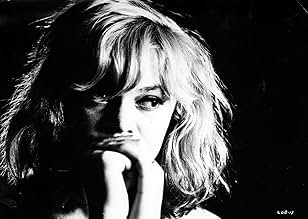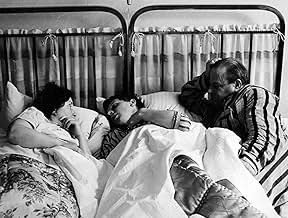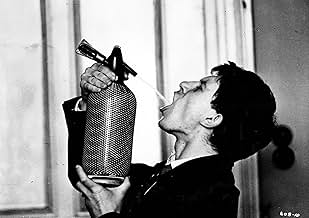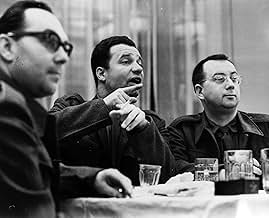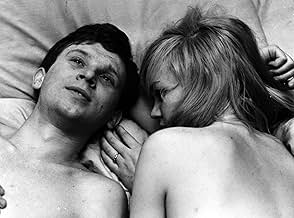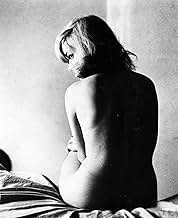IMDb रेटिंग
7.4/10
10 हज़ार
आपकी रेटिंग
अपनी भाषा में प्लॉट जोड़ेंFactory manager gets army reserves to boost female workers' morale. Local beauty spurns them for jazz pianist who seduces her. She leaves for Prague to find him but his parents are displease... सभी पढ़ेंFactory manager gets army reserves to boost female workers' morale. Local beauty spurns them for jazz pianist who seduces her. She leaves for Prague to find him but his parents are displeased when she arrives.Factory manager gets army reserves to boost female workers' morale. Local beauty spurns them for jazz pianist who seduces her. She leaves for Prague to find him but his parents are displeased when she arrives.
- 1 ऑस्कर के लिए नामांकित
- 2 जीत और कुल 4 नामांकन
Jana Novaková
- Jana
- (as Jana Nováková)
Jindrich Heidelberg
- Reditel
- (बिना क्रेडिट के)
Dana Valtová
- Bohunka
- (बिना क्रेडिट के)
फ़ीचर्ड समीक्षाएं
Part of what was known as the Czech New Wave in the 1960s and this particular title a great favourite of Film clubs and societies back in my younger days. Director Milos Foreman, of course, left what is now known as the Czech Republic for the US where he made films as diverse as The People vs Larry Flynt, Amadeus and One Flew Over the Cuckoo's Nest. Before leaving he mad a trio of film in his native country of which this is probably the best although his similar and later film The Firemen's Ball had, perhaps even greater impact internationally being in colour. For A Blonde in Love Foreman uses mostly local people from the village where he shot with, I believe, only one professional actor who it turns out was as influenced by the non actors as there were by him. The young blonde of the title was the sister of the director's wife and gives a wonderful performance. Indeed the whole piece, barely a story, is a joy to watch despite the cringe worthy moments, on the dance floor in particular. A warm and caring film that is beautifully shot and despite an obvious air of austerity throughout still managing to convey a feeling of positivity. Lovely.
This is such an exquisite cinematic weave of feelings, I was taken aback. But only half of it is there, the rest you'll have to supply which is even better in a way. Films come into being after all in that space between what is there and the experience in the eye.
But first. Watch it once straight through because it's funny as hell in that gentle way the Czech know so well, just light and bitter enough to be like getting tipsy on life, delighted at the tipsiness. It's well made and well acted, you can see why Milos Forman was quickly tapped by Hollywood.
Watching it once, you'll have this as your template—a teenage girl's impressionable drift through male sexual whims, and bittersweet realization in the end of heartbreak every time. Now bring all these other things to it:
The guys are only looking to get laid, this isn't about them.
It's a story the blonde girl tells to her girlfriend using the photograph of a boy, both real and imagined. Knowing this, is knowing everything else including the seduction is her exploring by allowing herself to be explored.
The gaffe with the bottle of wine sent by horny soldiers to the wrong table, the ugly ducklings instead of the pretty blonde. But it makes its way to the right one, and we have the two soldiers go after the two girls (but not the blondie), and that subplot abandoned with inviting glances.
Now her seduction (remember, still a story she will tell) but we actually skip sex, and go straight to the intimacy and youthful joking around on the bed which is what she yearns for, connection. And as she leaves the room, she meets the ugly duckling coming back to her room after her parallel night with the soldier.
The lecturing by a teacher on girls guarding a woman's honor, and she boards the first bus out of there. Is she mad? Looking for answers?
The cut from her alone in a country road boarding the bus, to a dance floor in the city filled with young couples, to TV footage of dancing girls in the parents' home. Amazing storytelling, because it is not of the story but the air around the girl lifting her from that road to wait for him in his house.
Her being 'locked' in the house, falling asleep to the mother's incessant nagging. Waking up again, now the boy is there but he's not who she would like him to be—she watches heartbroken through a peephole (a cinematic device) as the pettiness of family life is revealed.
So this is wonderful. It ends with her telling this story better than it is.
I would change a single detail—we'd never be shown who is in either of the two photographs.
It would be about any of these girls dreaming up all we've seen. (we see them all asleep in the end)
Sex safely explored inside the fantasy, and the fantasy both 'real' and imaginary, helter skelter so you wouldn't know where last day's glances end and the pillow book starts. The ugly duckling as the blonde. It can support all that and more, excellent, excellent stuff.
In order to appreciate why this is special, watch another Czech film called Daisies (Sedmikrásky), more inventive on the surface, more irreverent on the same subject, but it doesn't hit deep. It has the images but not the life that gives rise to them, there are both here, and how.
It's so good, it rivals Celine and Julie Go Boating on my list of great films, a similar film on the layered dreaming of a girl.
But first. Watch it once straight through because it's funny as hell in that gentle way the Czech know so well, just light and bitter enough to be like getting tipsy on life, delighted at the tipsiness. It's well made and well acted, you can see why Milos Forman was quickly tapped by Hollywood.
Watching it once, you'll have this as your template—a teenage girl's impressionable drift through male sexual whims, and bittersweet realization in the end of heartbreak every time. Now bring all these other things to it:
The guys are only looking to get laid, this isn't about them.
It's a story the blonde girl tells to her girlfriend using the photograph of a boy, both real and imagined. Knowing this, is knowing everything else including the seduction is her exploring by allowing herself to be explored.
The gaffe with the bottle of wine sent by horny soldiers to the wrong table, the ugly ducklings instead of the pretty blonde. But it makes its way to the right one, and we have the two soldiers go after the two girls (but not the blondie), and that subplot abandoned with inviting glances.
Now her seduction (remember, still a story she will tell) but we actually skip sex, and go straight to the intimacy and youthful joking around on the bed which is what she yearns for, connection. And as she leaves the room, she meets the ugly duckling coming back to her room after her parallel night with the soldier.
The lecturing by a teacher on girls guarding a woman's honor, and she boards the first bus out of there. Is she mad? Looking for answers?
The cut from her alone in a country road boarding the bus, to a dance floor in the city filled with young couples, to TV footage of dancing girls in the parents' home. Amazing storytelling, because it is not of the story but the air around the girl lifting her from that road to wait for him in his house.
Her being 'locked' in the house, falling asleep to the mother's incessant nagging. Waking up again, now the boy is there but he's not who she would like him to be—she watches heartbroken through a peephole (a cinematic device) as the pettiness of family life is revealed.
So this is wonderful. It ends with her telling this story better than it is.
I would change a single detail—we'd never be shown who is in either of the two photographs.
It would be about any of these girls dreaming up all we've seen. (we see them all asleep in the end)
Sex safely explored inside the fantasy, and the fantasy both 'real' and imaginary, helter skelter so you wouldn't know where last day's glances end and the pillow book starts. The ugly duckling as the blonde. It can support all that and more, excellent, excellent stuff.
In order to appreciate why this is special, watch another Czech film called Daisies (Sedmikrásky), more inventive on the surface, more irreverent on the same subject, but it doesn't hit deep. It has the images but not the life that gives rise to them, there are both here, and how.
It's so good, it rivals Celine and Julie Go Boating on my list of great films, a similar film on the layered dreaming of a girl.
A factory manager in rural Czechoslovakia bargains with the army to send men to the area, to boost the morale of his young female workers, deprived of male company since the local boys have been conscripted.
Loves of a Blonde has often been identified as one of the most significant and ambitious productions of the Czech New Wave, a movement in which a group of young filmmakers, many of whom were educated by the national film academy in Prague, including Forman, Ján Kadár, Věra Chytilová and Jiří Menzel, among others, took significant political risks by using cinema to protest the hypocrisy and absurdity of the Communist state.
I'll say it before and I'll say it again, of all the "new wave" movements in Europe, by far my favorite is the one that came out of the Czech cinema. The beauty, the honesty and sometimes the surrealism (though not here) is just spot on, and for me really captures what it means to have film as an art form. That Forman went on to become an international success is no surprise.
Loves of a Blonde has often been identified as one of the most significant and ambitious productions of the Czech New Wave, a movement in which a group of young filmmakers, many of whom were educated by the national film academy in Prague, including Forman, Ján Kadár, Věra Chytilová and Jiří Menzel, among others, took significant political risks by using cinema to protest the hypocrisy and absurdity of the Communist state.
I'll say it before and I'll say it again, of all the "new wave" movements in Europe, by far my favorite is the one that came out of the Czech cinema. The beauty, the honesty and sometimes the surrealism (though not here) is just spot on, and for me really captures what it means to have film as an art form. That Forman went on to become an international success is no surprise.
This is the second of Forman's Czech films I've watched after the other Criterion release, THE FIREMAN'S BALL (1967) - though that was via a late-night Italian TV broadcast some years ago; these two films constitute his most celebrated work from this early phase in his career.
While a pleasant and sharply-observed comedy-drama in itself, which must have seemed fresh at the time (particularly the intimate detail of its teenage romance), I feel that a lot of these unassuming but critically-acclaimed foreign films - often made under strained political conditions - tend to come off as overrated when viewed today (a similar recent example I encountered was CLOSELY WATCHED TRAINS [1966]). That said, the film benefits immensely from the wonderful cinematography by Miroslav Ondricek (Forman's longtime collaborator).
Besides, it also includes a couple of lengthy - and delightful - set-pieces: the party sequence, in which the heroine and her two best friends are picked up by a trio of geeky middle-aged soldiers; the scene at the home of the girl's 'boyfriend' (with whom she had a one-night stand), where she causes a commotion by turning up unannounced on his doorstep with a packed suitcase!
The DVD supplements comprise an amusing but irrelevant deleted scene, and an interesting 17-minute interview with Forman - in which he discusses the film's genesis and how the mix of professional and untrained actors proved providential, sealing its essential charm.
While a pleasant and sharply-observed comedy-drama in itself, which must have seemed fresh at the time (particularly the intimate detail of its teenage romance), I feel that a lot of these unassuming but critically-acclaimed foreign films - often made under strained political conditions - tend to come off as overrated when viewed today (a similar recent example I encountered was CLOSELY WATCHED TRAINS [1966]). That said, the film benefits immensely from the wonderful cinematography by Miroslav Ondricek (Forman's longtime collaborator).
Besides, it also includes a couple of lengthy - and delightful - set-pieces: the party sequence, in which the heroine and her two best friends are picked up by a trio of geeky middle-aged soldiers; the scene at the home of the girl's 'boyfriend' (with whom she had a one-night stand), where she causes a commotion by turning up unannounced on his doorstep with a packed suitcase!
The DVD supplements comprise an amusing but irrelevant deleted scene, and an interesting 17-minute interview with Forman - in which he discusses the film's genesis and how the mix of professional and untrained actors proved providential, sealing its essential charm.
Milos Forman's "Loves of a Blonde" which he made in Czechoslovakia in 1965 way before "Cuckoo Nest" and "Amadeus" tells a very simple bitter-sweet tale about a teenaged girl who works in a shoe factory in a small town. With sixteen girls to one man - her chances to find a man of her dreams were not very high. One evening, she meets an attractive and young piano player who tells her about Prague and compares her to a guitar that could've been painted by Picasso. After they spend the night together, he leaves and she travels to Prague to find him. The film has been one of my favorites for many years and my opinion did not change after I saw it again a week ago - funny, sad, tender, and realistic film about searching for love, broken promises, shattered hearts, and universality of hope.
क्या आपको पता है
- ट्रिवियाDirector/screenwriter Milos Forman got the idea for the movie when he met a young girl with a suitcase in the streets of Prague. Her story was very similar to the one in the film.
- कनेक्शनFeatured in Fejezetek a film történetéböl: A cseh új hullám (1990)
टॉप पसंद
रेटिंग देने के लिए साइन-इन करें और वैयक्तिकृत सुझावों के लिए वॉचलिस्ट करें
- How long is Loves of a Blonde?Alexa द्वारा संचालित
विवरण
- रिलीज़ की तारीख़
- कंट्री ऑफ़ ओरिजिन
- भाषा
- इस रूप में भी जाना जाता है
- Loves of a Blonde
- फ़िल्माने की जगहें
- Zruc nad Sázavou, चेक गणराज्य(formerly Czechoslovakia)
- उत्पादन कंपनियां
- IMDbPro पर और कंपनी क्रेडिट देखें
- चलने की अवधि
- 1 घं 28 मि(88 min)
- रंग
- ध्वनि मिश्रण
- पक्ष अनुपात
- 1.37 : 1
इस पेज में योगदान दें
किसी बदलाव का सुझाव दें या अनुपलब्ध कॉन्टेंट जोड़ें

